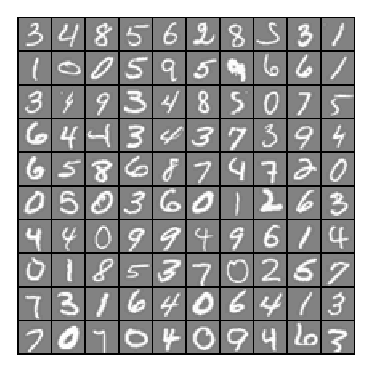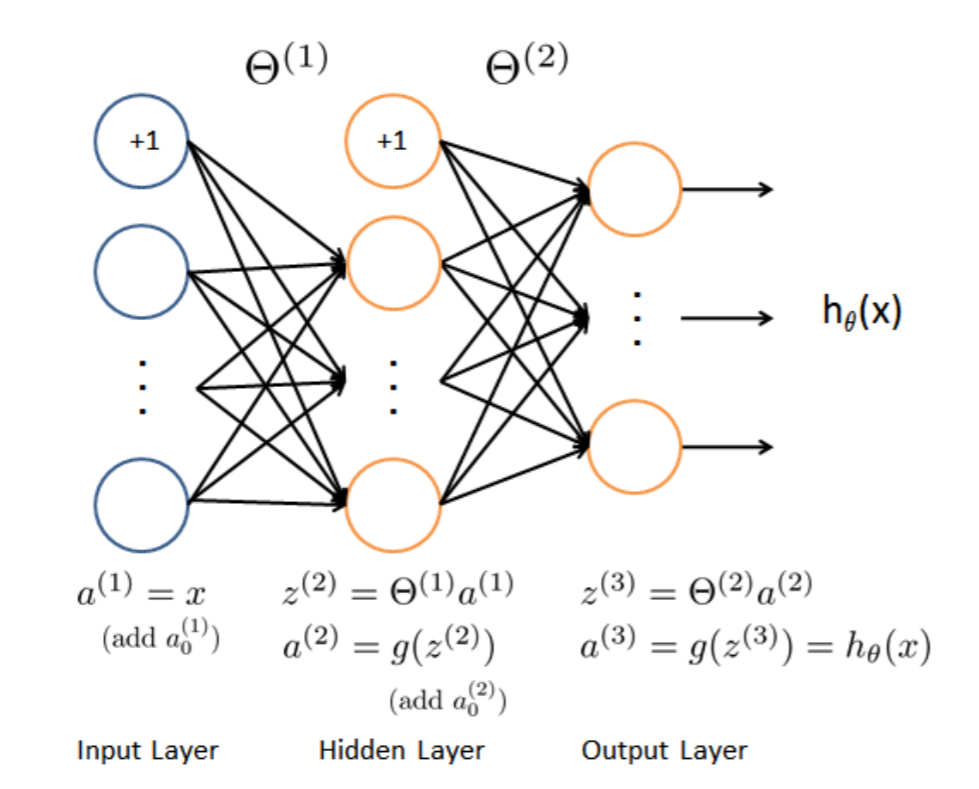背景:识别手写数字,给一组数据集ex3data1.mat,,每个样例都为灰度化为20*20像素,也就是每个样例的维度为400,加载这组数据后,我们会有5000*400的矩阵X(5000个样例),会有5000*1的矩阵y(表示每个样例所代表的数据)。现在让你拟合出一个模型,使得这个模型能很好的预测其它手写的数字。
(注意:我们用10代表0(矩阵y也是这样),因为Octave的矩阵没有0行)
我们随机可视化100个样例,可以看到如下图所示:

一:多类别分类(Multi-class Classification)
在这我们使用逻辑回归多类别分类去拟合数据。在这组数据,总共有10类别,我们可以将它们分成10个2元分类问题,最后我们选择一个让$h_ heta^i(x)$最大的$i$。
逻辑回归脚本ex3.m:

%% Machine Learning Online Class - Exercise 3 | Part 1: One-vs-all
% Instructions
% ------------
%
% This file contains code that helps you get started on the
% linear exercise. You will need to complete the following functions
% in this exericse:
%
% lrCostFunction.m (logistic regression cost function)
% oneVsAll.m
% predictOneVsAll.m
% predict.m
%
% For this exercise, you will not need to change any code in this file,
% or any other files other than those mentioned above.
%
%% Initialization
clear ; close all; clc
%% Setup the parameters you will use for this part of the exercise
input_layer_size = 400; % 20x20 Input Images of Digits
num_labels = 10; % 10 labels, from 1 to 10
% (note that we have mapped "0" to label 10)
%% =========== Part 1: Loading and Visualizing Data =============
% We start the exercise by first loading and visualizing the dataset.
% You will be working with a dataset that contains handwritten digits.
%
% Load Training Data
fprintf('Loading and Visualizing Data ...
')
load('ex3data1.mat'); % training data stored in arrays X, y
m = size(X, 1);
% Randomly select 100 data points to display
rand_indices = randperm(m);
sel = X(rand_indices(1:100), :);
displayData(sel);
fprintf('Program paused. Press enter to continue.
');
pause;
%% ============ Part 2a: Vectorize Logistic Regression ============
% In this part of the exercise, you will reuse your logistic regression
% code from the last exercise. You task here is to make sure that your
% regularized logistic regression implementation is vectorized. After
% that, you will implement one-vs-all classification for the handwritten
% digit dataset.
%
% Test case for lrCostFunction
fprintf('
Testing lrCostFunction() with regularization');
theta_t = [-2; -1; 1; 2];
X_t = [ones(5,1) reshape(1:15,5,3)/10];
y_t = ([1;0;1;0;1] >= 0.5);
lambda_t = 3;
[J grad] = lrCostFunction(theta_t, X_t, y_t, lambda_t);
fprintf('
Cost: %f
', J);
fprintf('Expected cost: 2.534819
');
fprintf('Gradients:
');
fprintf(' %f
', grad);
fprintf('Expected gradients:
');
fprintf(' 0.146561
-0.548558
0.724722
1.398003
');
fprintf('Program paused. Press enter to continue.
');
pause;
%% ============ Part 2b: One-vs-All Training ============
fprintf('
Training One-vs-All Logistic Regression...
')
lambda = 0.1;
[all_theta] = oneVsAll(X, y, num_labels, lambda); %10*401,每行表示标签i的拟合参数
fprintf('Program paused. Press enter to continue.
');
pause;
%% ================ Part 3: Predict for One-Vs-All ================
pred = predictOneVsAll(all_theta, X);
fprintf('
Training Set Accuracy: %f
', mean(double(pred == y)) * 100);
1,正则化逻辑回归代价函数(忽略偏差项$ heta_0$的正则化):
$J( heta)=-frac{1}{m}sum_{i=1}^{m}[y^{(i)}log(h_ heta(x^{(i)}))+(1-y^{(i)})log(1-h_{ heta}(x^{(i)}))]+frac{lambda }{2m}sum_{j=1}^{n} heta_j^{2}$
2,梯度下降:
不带学习速率(给之后fmincg作为梯度下降使用):
$frac{partial J( heta)}{partial heta_0}=frac{1}{m}sum_{i=1}^{m}[(h_ heta(x^{(i)})-y^{(i)})x^{(i)}_0]$ for $j=0$
$frac{partial J( heta)}{partial heta_j}=(frac{1}{m}sum_{i=1}^{m}[(h_ heta(x^{(i)})-y^{(i)})x^{(i)}_j])+frac{lambda }{m} heta_j $ for $jgeq 1$
代价函数代码:

function [J, grad] = lrCostFunction(theta, X, y, lambda)
%LRCOSTFUNCTION Compute cost and gradient for logistic regression with
%regularization
% J = LRCOSTFUNCTION(theta, X, y, lambda) computes the cost of using
% theta as the parameter for regularized logistic regression and the
% gradient of the cost w.r.t. to the parameters.
% Initialize some useful values
m = length(y); % number of training examples
% You need to return the following variables correctly
J = 0;
grad = zeros(size(theta));
% ====================== YOUR CODE HERE ======================
% Instructions: Compute the cost of a particular choice of theta.
% You should set J to the cost.
% Compute the partial derivatives and set grad to the partial
% derivatives of the cost w.r.t. each parameter in theta
%
% Hint: The computation of the cost function and gradients can be
% efficiently vectorized. For example, consider the computation
%
% sigmoid(X * theta)
%
% Each row of the resulting matrix will contain the value of the
% prediction for that example. You can make use of this to vectorize
% the cost function and gradient computations.
%
% Hint: When computing the gradient of the regularized cost function,
% there're many possible vectorized solutions, but one solution
% looks like:
% grad = (unregularized gradient for logistic regression)
% temp = theta;
% temp(1) = 0; % because we don't add anything for j = 0
% grad = grad + YOUR_CODE_HERE (using the temp variable)
%
h=sigmoid(X*theta);
theta(1,1)=0;
J=(-(y')*log(h)-(1-y)'*log(1-h))/m+lambda/2/m*sum(power(theta,2));%代价函数
grad=(X'*(h-y))./m+(lambda/m).*theta; %不带学习速率的梯度下降
% =============================================================
grad = grad(:);
end
拟合参数:

function [all_theta] = oneVsAll(X, y, num_labels, lambda)
%ONEVSALL trains multiple logistic regression classifiers and returns all
%the classifiers in a matrix all_theta, where the i-th row of all_theta
%corresponds to the classifier for label i
% [all_theta] = ONEVSALL(X, y, num_labels, lambda) trains num_labels
% logistic regression classifiers and returns each of these classifiers
% in a matrix all_theta, where the i-th row of all_theta corresponds
% to the classifier for label i
% Some useful variables
m = size(X, 1); %5000
n = size(X, 2); %400
% You need to return the following variables correctly
all_theta = zeros(num_labels, n + 1); %10*401
% Add ones to the X data matrix
X = [ones(m, 1) X]; %5000*401
% ====================== YOUR CODE HERE ======================
% Instructions: You should complete the following code to train num_labels
% logistic regression classifiers with regularization
% parameter lambda.
%
% Hint: theta(:) will return a column vector.
%
% Hint: You can use y == c to obtain a vector of 1's and 0's that tell you
% whether the ground truth is true/false for this class.
%
% Note: For this assignment, we recommend using fmincg to optimize the cost
% function. It is okay to use a for-loop (for c = 1:num_labels) to
% loop over the different classes.
%
% fmincg works similarly to fminunc, but is more efficient when we
% are dealing with large number of parameters.
%
% Example Code for fmincg:
%
% % Set Initial theta
% initial_theta = zeros(n + 1, 1);
%
% % Set options for fminunc
% options = optimset('GradObj', 'on', 'MaxIter', 50);
%
% % Run fmincg to obtain the optimal theta
% % This function will return theta and the cost
% [theta] = ...
% fmincg (@(t)(lrCostFunction(t, X, (y == c), lambda)), ...
% initial_theta, options);
%
for c=1:num_labels,
initial_theta = zeros(n + 1, 1); %401*1
options = optimset('GradObj', 'on', 'MaxIter', 50);
[theta] = ...
fmincg (@(t)(lrCostFunction(t, X, (y == c), lambda)), ...
initial_theta, options);
all_theta(c,:)=theta; %给标签c拟合参数
end;
% =========================================================================
end
3, 预测:我们根据我们拟合好的参数$ heta$去预测样例。我们可以看到我们使用逻辑回归去拟合对类别分类问题的准确率为95%。我们可以增加更多的特征,让我们的准确率更高,但因为过高的维度,最后我们可能要花费昂贵的训练代价。

function p = predictOneVsAll(all_theta, X)
%PREDICT Predict the label for a trained one-vs-all classifier. The labels
%are in the range 1..K, where K = size(all_theta, 1).
% p = PREDICTONEVSALL(all_theta, X) will return a vector of predictions
% for each example in the matrix X. Note that X contains the examples in
% rows. all_theta is a matrix where the i-th row is a trained logistic
% regression theta vector for the i-th class. You should set p to a vector
% of values from 1..K (e.g., p = [1; 3; 1; 2] predicts classes 1, 3, 1, 2
% for 4 examples)
m = size(X, 1);
num_labels = size(all_theta, 1);
% You need to return the following variables correctly
p = zeros(size(X, 1), 1);
% Add ones to the X data matrix
X = [ones(m, 1) X];
% ====================== YOUR CODE HERE ======================
% Instructions: Complete the following code to make predictions using
% your learned logistic regression parameters (one-vs-all).
% You should set p to a vector of predictions (from 1 to
% num_labels).
%
% Hint: This code can be done all vectorized using the max function.
% In particular, the max function can also return the index of the
% max element, for more information see 'help max'. If your examples
% are in rows, then, you can use max(A, [], 2) to obtain the max
% for each row.
%
temp = X*all_theta'; %(5000,401)*(401*10)
[maxx, p] = max(temp,[],2); %返回每行的最大值
% =========================================================================
end
二:神经网络(Neural Networks)
这里已经拟合好三层网络的参数$Theta1$和$Theta2$,只需加载ex3weights.mat就可以了。
中间层(hidden layer)$Theta1$的size为25x401,输出层( output layer)$Theta2$的size为10x26。
根据前向传播算法(Feedforward Propagation)来去预测数据,

$z^{(2)}=Theta^{(1)}x$
$a^{(2)}=g(z^{(2)})$
$z^{(3)}=Theta^{(2)}a^{(2)}$
$a^{(3)}=g(z^{(3)})=h_ heta(x)$

function p = predict(Theta1, Theta2, X)
%PREDICT Predict the label of an input given a trained neural network
% p = PREDICT(Theta1, Theta2, X) outputs the predicted label of X given the
% trained weights of a neural network (Theta1, Theta2)
% Useful values
m = size(X, 1);
num_labels = size(Theta2, 1);
% You need to return the following variables correctly
p = zeros(size(X, 1), 1);
% ====================== YOUR CODE HERE ======================
% Instructions: Complete the following code to make predictions using
% your learned neural network. You should set p to a
% vector containing labels between 1 to num_labels.
%
% Hint: The max function might come in useful. In particular, the max
% function can also return the index of the max element, for more
% information see 'help max'. If your examples are in rows, then, you
% can use max(A, [], 2) to obtain the max for each row.
%
X=[ones(m,1) X]; %而外增加一列偏差单位
item=sigmoid(X*Theta1'); %计算a^{(2)}
item=[ones(m,1) item];
item=sigmoid(item*Theta2');
[a,p]=max(item,[],2); %每行最大值
% =========================================================================
end
最后我们可以看到,预测的准确率为97.5%。
我的便签:做个有情怀的程序员。
